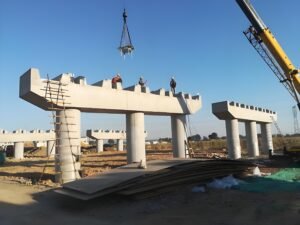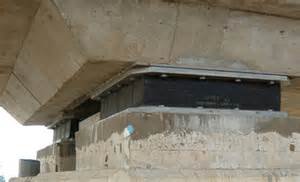Ponte cuscinetti are essential components of any bridge structure, providing support and stability to the bridge deck. They are designed to accommodate the thermal expansion and contraction of the bridge deck, as well as the loads imposed by traffic and other factors. Bridge bearings are typically made of steel, concrete, or rubber, and are available in a variety of shapes and sizes to meet the specific requirements of each bridge.
introduzione
Gli appoggi del ponte sono componenti strutturali che supportano e trasferiscono i carichi dalla sovrastruttura del ponte alla sottostruttura. Consentono il movimento e la rotazione della sovrastruttura a causa dell'espansione termica, della contrazione e di altri fattori, mantenendo l'integrità e la stabilità strutturale. Gli appoggi dei ponti svolgono un ruolo cruciale nel garantire la sicurezza e la longevità dei ponti.
Cuscinetti elastomerici: tipi, vantaggi e applicazioni
**Cuscinetti in elastomero: tipi, vantaggi e applicazioni**
Elastomeric bearing pads are essential components in bridge construction, providing support and flexibility to bridge structures. These pads are made of a durable elastomeric material, typically natural or synthetic rubber, and are designed to withstand the various loads and movements experienced by bridges.
**Tipi di cuscinetti elastomerici**
Esistono diversi tipi di cuscinetti elastomerici, ciascuno con le sue caratteristiche uniche:
* **Cuscinetti semplici:** Sono il tipo più semplice, costituiti da un singolo strato di elastomero. Sono adatti per applicazioni a basso carico.
* **Laminated pads:** These pads are made of multiple layers of elastomer, with steel or fabric reinforcement. They offer higher load capacity and flexibility.
* **Cuscinetti rinforzati:** Questi cuscinetti hanno un rinforzo in acciaio o tessuto incorporato nell'elastomero. Forniscono resistenza e durata eccezionali.
**Vantaggi dei cuscinetti elastomerici**
Elastomeric bearing pads offer numerous advantages over other types of bearings:
* **Flessibilità:** Possono adattarsi ai movimenti del ponte dovuti all'espansione termica, alla contrazione e all'attività sismica.
* **Load capacity:** They can support heavy loads while maintaining their shape and integrity.
* **Durabilità:** Sono resistenti agli agenti atmosferici, all'ozono e agli agenti chimici, garantendo prestazioni a lungo termine.
* **Ridotta manutenzione:** Richiedono una manutenzione minima, riducendo i costi correnti.
* **Efficacia in termini di costi:** Sono relativamente economici rispetto ad altri tipi di cuscinetti.
**Applicazioni dei cuscinetti elastomerici**
I cuscinetti elastomerici sono ampiamente utilizzati in varie applicazioni di ponti:
* **Ponti autostradali:** Forniscono supporto e flessibilità ai ponti autostradali, sopportando i carichi del traffico e i movimenti termici.
* **Ponti ferroviari:** Sono utilizzati nei ponti ferroviari per assorbire le vibrazioni e ridurre il rumore.
* **Pedestrian bridges:** They provide a safe and comfortable walking surface on pedestrian bridges.
* **Isolamento sismico:** Possono essere utilizzati nei sistemi di isolamento sismico per proteggere i ponti dai danni del terremoto.
**Conclusione**
Elastomeric bearing pads are versatile and reliable components that play a crucial role in bridge construction. Their flexibility, load capacity, durability, and cost-effectiveness make them an ideal choice for a wide range of bridge applications. By understanding the different types and advantages of elastomeric bearing pads, engineers can design and construct bridges that are safe, durable, and efficient.
Cuscinetti pot: progettazione, installazione e manutenzione
**Bridge Bearings: The Unsung Heroes of Structural Stability**
In the realm of bridge engineering, bridge bearings play a crucial role in ensuring the safety and longevity of these majestic structures. These unsung heroes, often hidden from view, are responsible for transferring the weight of the bridge deck and traffic loads to the supporting piers or abutments.
Pot bearings, a specific type of cuscinetto del ponte, have gained popularity due to their exceptional performance and versatility. They consist of a cylindrical steel pot filled with a rubber compound, which provides a flexible and durable connection between the bridge deck and the supporting structure.
**Considerazioni sul design**
The design of pot bearings involves careful consideration of several factors, including the bridge’s weight, traffic loads, and environmental conditions. Engineers must ensure that the bearings can withstand the compressive and shear forces imposed on them while maintaining their structural integrity. The rubber compound used in the bearings is specially formulated to provide the necessary flexibility and damping properties, reducing vibrations and ensuring a smooth ride for vehicles.
**Installazione e manutenzione**
Proper installation is essential for the optimal performance of pot bearings. They must be precisely aligned and leveled to prevent uneven loading and premature failure. Regular maintenance is also crucial to ensure their longevity. This includes periodic inspections to check for any signs of wear, damage, or corrosion.
**Vantaggi dei cuscinetti a vaso**
Pot bearings offer numerous advantages over other types of bridge bearings. Their flexibility allows for thermal expansion and contraction of the bridge deck, preventing damage due to temperature fluctuations. They also provide excellent damping properties, reducing vibrations and improving the overall stability of the bridge. Additionally, pot bearings are relatively easy to install and maintain, making them a cost-effective solution.
**Conclusione**
Bridge bearings, particularly pot bearings, are indispensable components of modern bridge design. Their ability to transfer loads, accommodate movement, and provide damping makes them essential for ensuring the safety and longevity of these vital structures. By understanding the design, installation, and maintenance requirements of pot bearings, engineers can create bridges that stand the test of time and provide a safe and reliable passage for generations to come.
Cuscinetti sferici: vantaggi, limiti e casi di studio
**Bridge Bearings: Spherical Bearings**
Spherical bearings play a crucial role in supporting and accommodating the movements of bridges. These bearings allow for rotation and translation in multiple directions, ensuring the structural integrity and longevity of the bridge.
**Benefits of Spherical Bearings**
Spherical bearings offer several advantages over other types of bearings:
* **Low friction:** The spherical shape minimizes friction, reducing the forces required to move the bridge.
* **Multi-directional movement:** They allow for rotation and translation in all directions, accommodating thermal expansion, settlement, and other movements.
* **Load distribution:** The spherical surface distributes loads evenly, preventing stress concentrations and premature failure.
* **Durability:** Spherical bearings are made of high-strength materials, such as stainless steel or bronze, ensuring long-term performance.
**Limitations of Spherical Bearings**
While spherical bearings provide numerous benefits, they also have some limitations:
* **Cost:** Spherical bearings can be more expensive than other types of bearings due to their complex design and manufacturing process.
* **Maintenance:** They require regular inspection and maintenance to ensure proper operation and prevent premature failure.
* **Size:** Spherical bearings can be bulky, which may limit their use in space-constrained applications.
**Case Studies**
Spherical bearings have been successfully used in numerous bridge projects worldwide. Here are a few notable examples:
* **Golden Gate Bridge:** The iconic Golden Gate Bridge in San Francisco utilizes spherical bearings to accommodate the bridge’s thermal expansion and seismic movements.
* **Sydney Harbour Bridge:** The Sydney Harbour Bridge in Australia features spherical bearings that allow for rotation and translation due to wind loads and temperature changes.
* **Akashi Kaikyō Bridge:** The Akashi Kaikyō Bridge in Japan, the world’s longest suspension bridge, employs spherical bearings to support its massive weight and withstand high winds.
**Conclusione**
Spherical bearings are essential components of modern bridges, providing low friction, multi-directional movement, and load distribution. While they may have some limitations, their benefits far outweigh their drawbacks. The successful implementation of spherical bearings in numerous bridge projects worldwide demonstrates their reliability and effectiveness in ensuring the structural integrity and longevity of these critical infrastructure assets.
Selezione del cuscinetto di appoggio del ponte: fattori da considerare
**Bridge Bearing Pad Selection: Factors to Consider**
When it comes to bridge construction, selecting the right bearing pads is crucial for ensuring the longevity and safety of the structure. These pads play a vital role in transferring loads from the bridge deck to the substructure, accommodating movements, and preventing damage due to thermal expansion and contraction.
**Material:**
The material of the bearing pad is a primary consideration. Elastomeric pads, made from natural or synthetic rubber, are commonly used due to their flexibility, durability, and ability to withstand high loads. Other materials include steel, PTFE (Teflon), and fiber-reinforced polymers, each with its own advantages and disadvantages.
**Load Capacity:**
The load capacity of the bearing pad must be sufficient to support the weight of the bridge deck and any additional loads, such as traffic or wind. Engineers carefully calculate the required load capacity based on the bridge design and expected usage.
**Movement Accommodation:**
Bearing pads allow for movement in various directions, including vertical, horizontal, and rotational. This movement accommodation is essential to prevent stress concentrations and damage to the bridge structure. The type of bearing pad selected will depend on the anticipated movements and the design of the bridge.
**Environmental Conditions:**
The environmental conditions at the bridge site must be considered when selecting bearing pads. Factors such as temperature extremes, moisture, and chemical exposure can affect the performance and lifespan of the pads. Elastomeric pads, for example, are susceptible to ozone degradation, while steel pads may be prone to corrosion.
**Cost and Maintenance:**
The cost of the bearing pads and their maintenance requirements should also be taken into account. Elastomeric pads are generally more cost-effective than other materials, but they may require periodic replacement due to aging or wear. Steel pads, on the other hand, have a longer lifespan but may require more frequent inspection and maintenance.
**Installation and Inspection:**
Proper installation and regular inspection of bearing pads are essential for their optimal performance. Experienced contractors should handle the installation to ensure correct alignment and load distribution. Regular inspections should be conducted to monitor the condition of the pads and identify any potential issues early on.
By carefully considering these factors, engineers and bridge designers can select the most appropriate bearing pads for their specific project. These pads will play a critical role in ensuring the safety, durability, and longevity of the bridge, allowing it to withstand the demands of traffic and the elements for years to come.
Tecnologie innovative dei cuscinetti del ponte per prestazioni migliorate
**Bridge Bearing: The Unsung Hero of Bridge Performance**
Bridges, the majestic structures that connect us across rivers, valleys, and cities, rely on a crucial yet often overlooked component: bridge bearings. These unsung heroes play a pivotal role in ensuring the safety, durability, and performance of our bridges.
Bridge bearings are the interfaces between the bridge superstructure and the substructure. They transfer loads from the superstructure to the substructure, allowing for movement and rotation due to thermal expansion, traffic loads, and seismic events. Without proper bearings, bridges would be rigid and prone to failure under these dynamic conditions.
Over the years, bridge bearing technologies have evolved significantly to meet the demands of modern bridge design. Traditional bearings, such as steel rockers and elastomeric pads, have served their purpose well. However, innovative bearing technologies are emerging to enhance bridge performance even further.
One such innovation is the use of high-performance polymers. These polymers offer exceptional durability, low friction, and resistance to corrosion. They can withstand extreme temperatures and heavy loads, making them ideal for bridges in harsh environments.
Another promising technology is the development of self-aligning bearings. These bearings automatically adjust to changes in the bridge’s geometry, ensuring optimal load distribution and reducing stress concentrations. This feature is particularly beneficial for bridges with complex geometries or those subjected to significant seismic activity.
In addition to improving performance, innovative bridge bearings also offer cost-effective solutions. By reducing maintenance requirements and extending the lifespan of bridges, these bearings can save significant resources over the long term.
The adoption of innovative bridge bearing technologies is essential for the future of bridge engineering. By embracing these advancements, we can create bridges that are safer, more durable, and more efficient. These unsung heroes will continue to play a vital role in connecting our communities and ensuring the smooth flow of traffic for generations to come.
Domande e risposte
**Domanda 1:** Cos'è un ponte?
**Risposta:** Un cuscinetto del ponte è un componente strutturale che supporta l'impalcato del ponte e trasferisce i carichi dall'impalcato alla sottostruttura.
**Domanda 2:** Quali sono i diversi tipi di appoggi del ponte?
**Risposta:** I tipi più comuni di appoggi per ponti includono appoggi elastomerici, appoggi in acciaio e appoggi per vasi.
**Domanda 3:** Qual è la funzione portante di un ponte?
**Risposta:** I cuscinetti del ponte consentono il movimento dell'impalcato del ponte a causa dell'espansione termica, della contrazione e di altri fattori, pur mantenendo l'integrità strutturale.
**Domanda 4:** Quali sono i fattori da considerare nella scelta di un appoggio per ponte?
**Risposta:** I fattori da considerare includono capacità di carico, requisiti di movimento, durata e costi.
**Domanda 5:** Come vengono installati gli appoggi del ponte?
**Risposta:** Gli appoggi del ponte vengono generalmente installati posizionandoli sulla sottostruttura e quindi abbassando su di essi l'impalcato del ponte.
Conclusione
**Conclusione**
Gli appoggi dei ponti svolgono un ruolo cruciale nell'integrità strutturale e nelle prestazioni dei ponti. Forniscono supporto, trasferiscono i carichi e assecondano i movimenti dovuti all'espansione termica, alla contrazione e all'attività sismica. Selezionando e progettando appoggi adeguati, gli ingegneri possono garantire la sicurezza, la durata e la funzionalità dei ponti in varie condizioni di carico e fattori ambientali.



